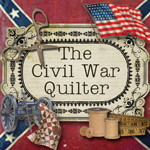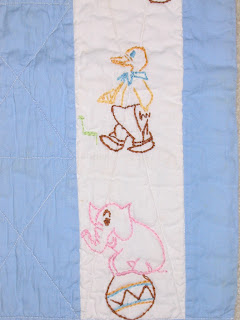I am always grateful for an opportunity to share my quilts and our wonderful island library has given me my 2nd opportunity in two years to do so!
Lopez Island Library is a community run library and is the most enchanting library I have ever visited. A lot of it has to do with the volunteers! The fact that it was once a one-room schoolhouse also adds to the charm. You can read its story
here.
 |
| Photo courtesy of Lopez Island Library |
Besides books, this amazing community library also makes musical instruments available for check out!
Crib and Doll Quilts - Full of History!
 |
| Click on photos to enlarge. |
“Quaddie Quiltie” detail
Pattern series by Ruby Short McKim
Design first available in 1916.
This quilt bears a label on the back that reads: Carol Burr Baby quilt made for Richard born 1918.
Ruby Short McKim (1891-1976) studied art under the renowned Frank Alvah Parsons at the New York School of Fine and Applied Arts in New York City. Although the reason is not known for certain, finances probably had a lot to do with returning home.
Once home, Ruby began to teach in the public schools and in 1912 became the Supervisor of Drawing for the Independence School system, overseeing all grades elementary through high school.
“Bedtime Quilt”, or the “Quaddie Quiltie” series as it soon became known, launched McKim’s “official” career on May 7, 1916 in the Kansas City Star. It was her first published series. Quilt historians also believe it to be the first syndicated quilt pattern series.
Although the red sashing is badly worn in places, especially across the top border, I was thrilled to stumble upon such an early quilt of Ruby’s first series.
This first series was a joint copyright venture with well known author Thornton Burgess. Burgess, who died in 1965 at the age of 91, wrote over 170 books and 15,000 stories throughout his life. His characters, such as: Peter Rabbit, Joe Otter, Hooty the Owl, Jerry Muskrat, and Bobby Raccoon are famous worldwide. It was an auspicious beginning to McKim’s career to land this joint venture.
Visit the resurrected the pattern business Ruby created! Her granddaughters are re-issuing all the patterns, each accompanied by a very special history booklet.
You can read my lengthily article on Ruby McKim here.
Colonial History - Another McKim Pattern
Pattern series by Ruby Short McKim.
First appeared in newspaper syndication in 1930.
This quilt was probably made in the 1930s. What a great way to make history come alive to a child. What a great prompt for story telling at bedtime. When showing it to children, I always ask "How many of these scenes can you indentify? Can you find George Washington? What about Daniel Boone?"
One of America's Cultural Icons - the Cowboy!
3) Cross-stitched Cowboy Crib Quilt
Made ca. 1955-1965
Source of pattern still unknown at this time.
By studying quilt designs you can learn some great history along the way.
The word "cowboy" appeared in the English language by 1725. It appears to be a direct English translation of vaquero, a Spanish word for the man who managed cattle while mounted on horseback. It was derived from vaca, meaning "cow," which came from the Latin word vacca.
Another English word for a cowboy, buckaroo, is an Anglicization of vaquero. At least one linguist has speculated that the word "buckaroo" derives from the Arabic word bakara or bakhara, also meaning "heifer" or "young cow", and may have entered Spanish during the centuries of Islamic rule. Originally, the term may have been intended literally—"a boy who tends cows."
However, by 1849 it had developed its modern sense as an adult cattle handler of the American West. "Cowhand" appeared in 1852, and "cowpoke" in 1881, originally restricted to the individuals who prodded cattle
with long poles to load them onto railroad cars for shipping. Read more of Wikipedia's great article on cowboys and cowgirls here.
The following is from Texas Quilts, Texas Women by Suzanne Yabsley.
Part of a cowboy’s gear was the bedroll… During a trail drive the men often worked a 16-20 hour day…Bedding had to be portable and uncomplicated. The Texas cowboy’s bedroll was often a heavy quilt, which he called a suggan. Suggans were made from old wool pants, tailors squares. Or the legs of khakis or blue jeans….Some old timers relate that the cowboys themselves sometimes helped “tack” their suggans. One former ranch hand recalls the general use of this type of quilt and remembers hearing cowboys say, after a hard day’s work, “I can’t wait to get into them suggans!”
This space in the library is perfect for doll quilts.
Modernism — the Art Deco designs in the lightweight fabrics in this little quilt are wonderful. I have never seen a doll quilt with such a marvelous array of them.
The actual name for this pattern depends upon the light and dark fabric choices and their placement. I simply call it Windmill. Someone else might see a flower or star in it and give it a different name. If you turned the setting one tick to the right, it could possible be called a Maltese Cross variation.
(6) Rainbow - One Patch Square
The arrangement of this cascading sherbet color scheme had a popular variety of arrangements in the ‘30s. This little jewel needs some TLC as the lightest colored fabric has split.
Doll Quilt circ 1940s-50s
This is a simple Nine Patch pattern with three nine-patch blocks across and three down with sashing added at top only. The final effect or design comes from the choices you make in the placement of your lights and darks. It is an easy pattern to play with if you like to experiment with color!
Doll Quilt circa 1900-1930
It is interesting to study the color changes that occurred in fabrics between 1890 and 1920. The lighter plaids and stripes had begun to show up just before the turn of the century but it really wasn’t until after 1905 that they became the rage for use in every day dresses and children’s clothing. Virginia Gunn presented an excellent paper at the 2007
American Quilt Study Group Seminar on early 20th century quilts —
"The Gingham Dog or the Calico Cat: Grassroots Quilts of the Early Twentieth Century." The fabrics in this little quilt are a perfect example of the quilts she wrote about.
This is a variation of the Log Cabin pattern that became quite popular just after the Civil War and remained so for a very long time. This variation is quite simple to make and a good one to start a beginner on.
This charmer is a combination of some very traditional patterns. Again these two patterns have had a number of different names. The purple could be a Square-in-a-Square. The cadet blue corner blocks could be Flower Basket. What makes this quilt “zing” are the two red strips. I personally like the lack of “striving for perfection” in the matching of seams in the older quilts. It imbues them with a greater feel of warmth in my humble opinion.
10) Sunbonnet Sue and Scottie
Scotties (and West Highland Whites) were very popular in the USA from the 1920s through the 1950s. President Franklin Delano Roosevelt’s famous Scottie (Fala) brought the breed to the public’s attention once more but did not create the Scottie sensation in the USA to begin with.
Girls in bonnets were first popularized in 1878 by the publication of Kate Greenway first illustrated book. In 1884 the first knock-off Kate Greenway illustrations were published for needlework. Bertha Corbett self-published her first illustrated storybook The Sunbonnet Babies in 1900. Her book caught the attention of Eulalie Osgood Grover, a writer of children's school primers. Bertha was hired as the illustrator of Ms. Grover's primers series which became The Sunbonnet Babies Primer series.
Bernhardt Wall, another early 20th century artist, also got into the act and created his own distinctive bonneted little girls. Over the last century both Corbett’s and Wall’s simplified designs have been adapted for Redwork embroidery.
Sunbonnet Sue as an appliquéd figure became popular beginning in the early 1930s and remains so today. In the 1930s outline black embroidery was often added around appliquéd figures.
This particular crib quilt is not as finely made as most you will see from the 1930s. It is rather awkwardly embroidered in a blanket stitch around the appliqué. It is a very thick quilt, yet hand quilted. It is the first Sunbonnet Sue quilt I have personally seen with the Scottie dog added.

Click on the photo twice to see the stitching up close. You can see how she first outlined each dog and child in a black running stitch. Then she stitched a blanket stitch around each figure, crude though it may be compared to most examples of outlined applique of this period.
One of the members of the Quilt History List told me that she is reasonably certain the pattern came from one of the
Colonial Pattern series booklets from the 1950s. She further added that Betty Hagerman cited this pattern in her book,
A Meeting of the Sunbonnet Children. The children are featured in various poses including with butterfly, watering can and balloon, etc. One of the poses includes a girl in similar garb bending over a Scotty dog. Another pattern to track down and add to my documentation!
The last quilt in the exhibit — Donald's 1944 Tile Quilt (50x33)
I'll go back to the library and take clearer photos tomorrow. This is what I grabbed off eBay when I bought it.
This delightful find has the date 1944 embroidered on it plus the name Donald.
I first enountered a Tile Quilt at the International Quilt Festival in Houston in an antique quilt dealers booth. It caught my eye as I was cruising by and it was such an odd-duck I put on my brakes and took a photo.
I looked and looked at this quilt for the longest time until I finally realized....all those little pieces are just "left-over scraps" randomly placed in the maker's own "made-up" pattern. In some instance she was almost able to make it look like a snowflake-type pattern!
My 1944 Tile crib quilt really has no pattern to it but it was born of the same idea....left-over scraps randomly placed on a background fabric, no scrap too small or too oddly shaped to NOT use! AQSG friends Bobbi Finley and Carol Gilham published a book under C&T's banner in 2010 about this unusual pattern style —
"The Tile Quilt Revival".
Until next time, keep those needles flying! We don't want to run out of quilts to research and document!
KarenQuilt
PS: Want to see still more doll quilts?
http://edythoneill.blogspot.com/2011/11/lovely-doll-quilts-antique-and-new.html
























































